|
57. Plebejus argyrognomon (Bergsträsser, 1779) / Reverdin’s blue / Lycaenidae – Polyommatinae
NL: kroonkruidblauwtje / D: Kronwicken-Bläuling, Kronwicken-Silberfleckbläuling / F: azuré des coronilles
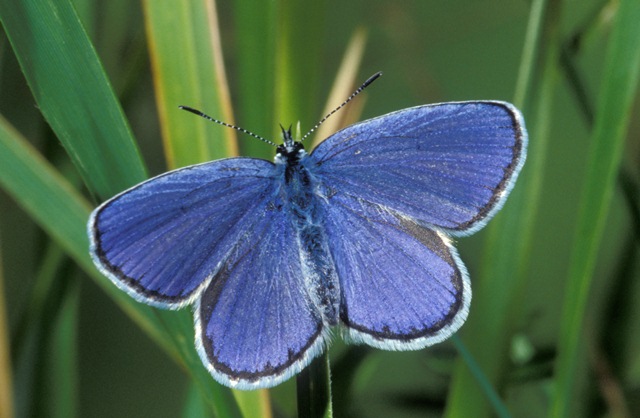 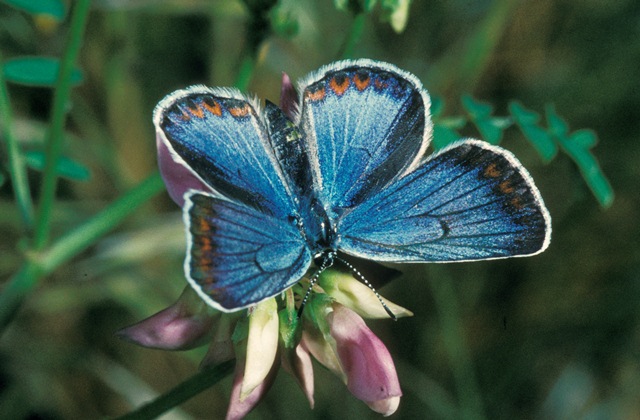 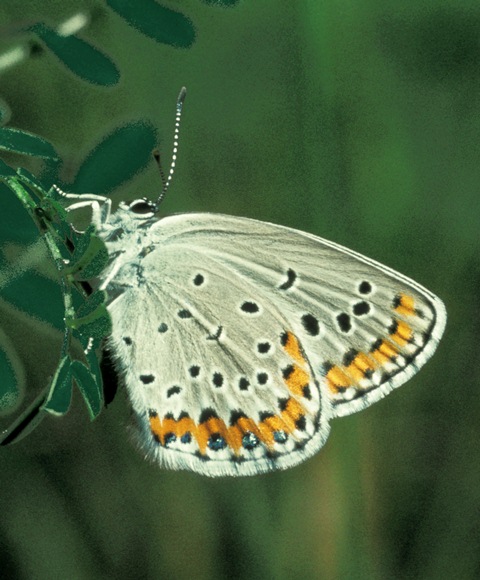
Photographs: Frits Bink ©.
Small, wing length 15 (14-17) mm. Occurred up to 1980 in south Wallonia but is now extinct in the Benelux. However, in the adjoining part of Lorraine, France it is widely distributed.
Butterflies of the first brood on the wing from end-May until early-July and the second brood from mid-July until early-September.
Known from sub-continental to continental climates, amplitude 7 to 17. Required heat sum 700°d, maximum tolerated 1800°d, corresponding climate windows 24 and 35 weeks.
The species occurs widely in northwest France in abandoned grassland, so this species is well prepared for changes in agriculture.
Ecological characteristics
Behaviour over time
Overwintering: egg on the woody parts of the stem of the host plant near to the ground.
Reproduction: oviposition starts after 4-6 days in first brood when the body contains about 100 eggs, and 41 (28-48) eggs in the second brood. Estimated potential reproduction in first brood 1.8 times as much, in the second brood 2.4 times as much.
Larval feeding periods: 6 weeks in period mid-April until early-July, 5 weeks in period end-June until end-August.
Generations: usually two but in Scandinavia only one.
Spreading of risk: not observed.
Life cycle: egg 25-41 weeks in overwintering generation, 7 (6-8) days in summer generation; larva 56 (43-64) days in first generation, 34 (27-40) days in second one; pupa 12 (8-14) days.
Life span of adult: rather long, 3 weeks.
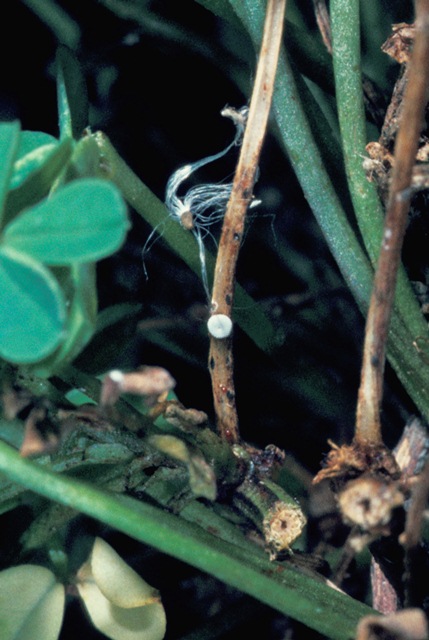 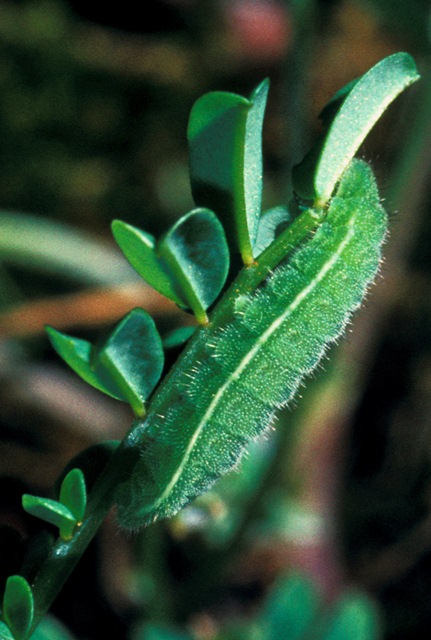
Photographs: Frits Bink ©.
Behaviour in space
From stay-at-home to migrant: stay-at-home, spatial requirement modest.
Finding a mate: male patrols within a small area.
Orientation in the landscape: gradient between tall grass vegetation and scrub or wood.
Oviposition: first generation on the leaves of the host, second generation on the woody stems near to the ground.
Defence
Threats from other organisms: no special defence.
Myrmecophily: moderate, full array of ant-attracting and appeasing organs present but tentacles not used when inspected by ants.
Threats from the environment: succession in the vegetation becoming invaded by shrub or wood.
Feeding habits
Adult: nectar on flowers in herb vegetation.
Larva: feeds nearly all the time on mature leaves.
Larval foodplants
Plant species: Fabaceae, Securigea varia, in Scandinavia Astragalus glycyphyllos.
Journal
Rearing experiments:
1. Based on specimens from Baudonvillers near St. Dizier, France:
11 September 1982: six females captured.
14 September: only one female laid eggs, three in total. Dissected females.
22 September: no sign of development in the eggs.
3 October: eggs unchanged.
Overwintered outdoors.
3 April 1983: pot taken indoors.
8 April: one larva seen.
18 April: two larvae at end of L1 were green (those of P. argus and P. idas are brown).
3 May: larvae in third instar.
15 May: larvae moulted to last instar.
23 May: larvae fully grown and were visited by Myrmica ants, lateral organs of the larvae were not seen but their honey-gland were licked frequently by the ants.
28 May: larvae pupated.
10 June: two adults appeared, females.
2. Based on specimens from Dun-sur-Meuse, France:
Report.
11 June 1984: two females captured.
18 June: ten eggs laid on Securigera varia on underside of the stems.
26 June: eggs on Securigera hatched.
28 June: eggs on Astragalus glycophyllos hatched.
5 July: larvae in second instar.
9 August: larvae 8 mm in length.
13 August: end fourth instar, 10 mm in length.
17 August: biggest larvae fully grown, ate also twigs of the host.
20 August: pupated.
3. Based on specimens from Lion-devant-Dun, France:
10 July 1985: females captured.
14 July: eggs laid on the leaves.
20 July: eggs hatched.
28 July: larva in second instar.
26 August: one larva, others pupated, one hatched: male.
1 September: ten pupae hatched: nine males, one female.
9 September: first eggs laid on the woody parts of the stems of Securigera.
22 September: two last females dead, not more than 30 eggs laid.
Table 57-1. Results of dissections

Table 57-2. Collection and observation localities
F, Baudonvillers 48° 41’ 35”N – 5° 03’ 00”E; 11 September 1982.
F, Lorraine, Dieue-sur-Meuse 49° 05’ 11”N – 5° 27’ 25”E; 11 July 1984, 19 August 1984, 10 July 1985.
F, Lorraine, Dun-sur-Meuse, 250 m, 49° 24’ 13”N – 5° 15’ 14”E; 12 June 1984.
F, Lorraine, Lion-devant-Dun, 300 m, 49° 23’ 40”N – 5° 14’ 03”E; 12 June 1984, 11 July 1984, 10 July 1985.
F, Lorraine, Rupt devant Saint-Mihiel, 280 m, 48° 53’ 01”N – 5° 24’ 10”E; 28 June 2006.
F, Pagny-la-Blanche-Côte, 308 m, 48° 32’ 37”N – 5° 42’ 58’E; 10 July 1985, 5 July 2006.
Fig. 57-1. Plebejus argyrognomon, phenogram adapted from Ebert & Rennwald 1991b: 330.
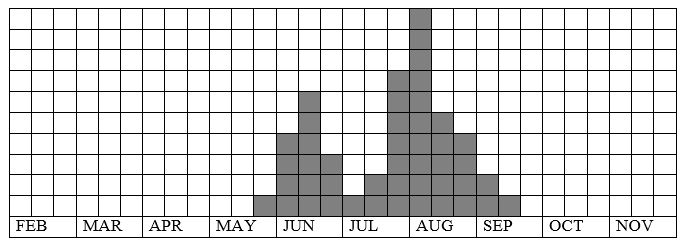
Fig. 57-2. Plebejus argyrognomon, habitat characteristics.
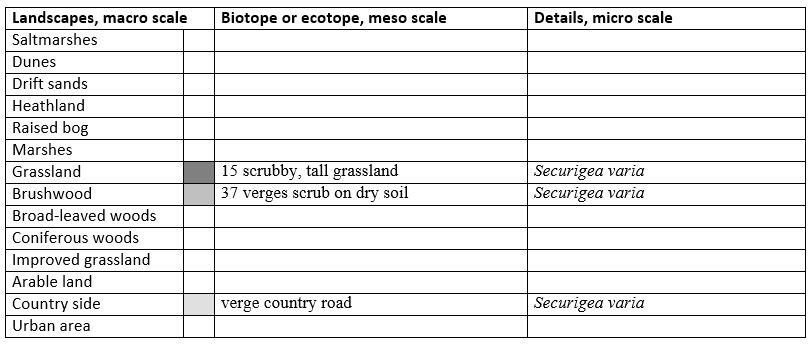
Fig. 57-3. Plebejus argyrognomon, climate matrix, heat-sums 700 - 1800°d.
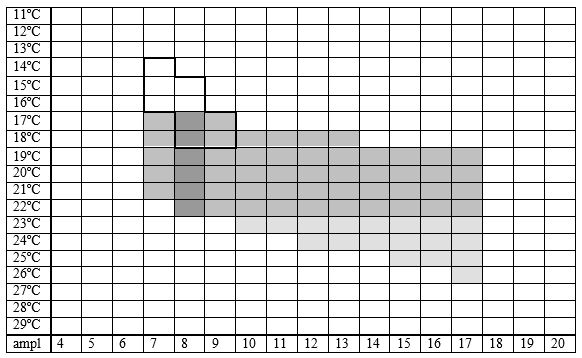
|










